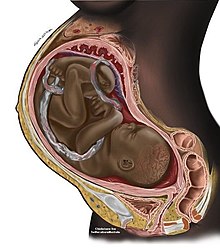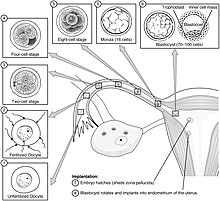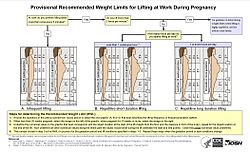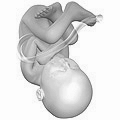Pregnancy
| Pregnancy | |
|---|---|
| Other names | Gestation |
| Frequency | 213 million (2012)[11] |
| Deaths | |
Pregnancy is the time during which one or more offspring develops (gestates) inside a woman's uterus (womb).[4][13] A multiple pregnancy involves more than one offspring, such as with twins.[14]
Pregnancy usually occurs by
Pregnancy is divided into three trimesters of approximately three months each. The
Terminology

Associated terms for pregnancy are gravid and parous. Gravidus and gravid come from the
A woman who has never been pregnant is referred to as a nulligravida. A woman who is (or has been only) pregnant for the first time is referred to as a primigravida,
A pregnancy is considered term at 37 weeks of gestation. It is preterm if less than 37 weeks and postterm at or beyond 42 weeks of gestation. American College of Obstetricians and Gynecologists have recommended further division with early term 37 weeks up to 39 weeks, full term 39 weeks up to 41 weeks, and late term 41 weeks up to 42 weeks.[24] The terms preterm and postterm have largely replaced earlier terms of premature and postmature. Preterm and postterm are defined above, whereas premature and postmature have historical meaning and relate more to the infant's size and state of development rather than to the stage of pregnancy.[25][26]
Demographics and statistics
About 213 million pregnancies occurred in 2012, of which, 190 million (89%) were in the
Signs and symptoms


The usual signs and symptoms of pregnancy do not significantly interfere with activities of daily living or pose a health-threat to the mother or baby. However, pregnancy complications can cause other more severe symptoms, such as those associated with anemia.
Common signs and symptoms of pregnancy include:
- Tiredness
- Morning sickness
- Constipation
- Pelvic girdle pain
- Back pain
- Braxton Hicks contractions. Occasional, irregular, and often painless contractions that occur several times per day.
- hydrostatic pressurein lower extremities.
- Low blood pressure often caused by compression of both the inferior vena cava and the abdominal aorta (aortocaval compression syndrome).
- bladderby the expanding uterus.
- Urinary tract infection[29]
- Varicose veins. Common complaint caused by relaxation of the venous smooth muscle and increased intravascular pressure.
- Hemorrhoids (piles). Swollen veins at or inside the anal area. Caused by impaired venous return, straining associated with constipation, or increased intra-abdominal pressure in later pregnancy.[30]
- Regurgitation, heartburn, and nausea.
- Stretch marks
- Breast tenderness is common during the first trimester, and is more common in women who are pregnant at a young age.[31]
- Melasma, also known as the mask of pregnancy, is a discoloration, most often of the face. It usually begins to fade several months after giving birth.
Timeline
| Event | Gestational age
(from the start of the |
Fertilization age | Implantation age |
|---|---|---|---|
Menstrual period begins
|
Day 1 of pregnancy | Not pregnant | Not pregnant |
| Has sex and ovulates | 2 weeks pregnant | Not pregnant | Not pregnant |
cleavage stage begins[32]
|
Day 15[32] | Day 1[32][33] | Not pregnant |
Implantation of blastocyst begins
|
Day 20 | Day 6[32][33] | Day 0 |
| Implantation finished | Day 26 | Day 12[32][33] | Day 6 (or Day 0) |
missed period
|
4 weeks | Day 15[32] | Day 9 |
detected
|
5 weeks, 5 days[32] | Day 26[32] | Day 20 |
| Fetal stage begins | 10 weeks, 1 day[32] | 8 weeks, 1 day[32] | 7 weeks, 2 days |
| First trimester ends | 13 weeks | 11 weeks | 10 weeks |
| Second trimester ends | 26 weeks | 24 weeks | 23 weeks |
| Childbirth | 39–40 weeks | 37–38 weeks[33]: 108 | 36–37 weeks |
The
Start of gestational age
The
- Directly calculating the days since the beginning of the last menstrual period.
- Early reference group of pregnancies of known gestational age (such as calculated from last menstrual periods), and using the mean gestational age of other embryos or fetuses of the same size. If the gestational age as calculated from an early ultrasound is contradictory to the one calculated directly from the last menstrual period, it is still the one from the early ultrasound that is used for the rest of the pregnancy.[34]
- In case of co-incubation and adding 14 days.[35]
Trimesters
Pregnancy is divided into three trimesters, each lasting for approximately three months.[4] The exact length of each trimester can vary between sources.
- The first trimester begins with the start of gestational age as described above, that is, the beginning of week 1, or 0 weeks + 0 days of gestational age (GA). It ends at week 12 (11 weeks + 6 days of GA)[4] or end of week 14 (13 weeks + 6 days of GA).[36]
- The second trimester is defined as starting, between the beginning of week 13 (12 weeks +0 days of GA)[4] and beginning of week 15 (14 weeks + 0 days of GA).[36] It ends at the end of week 27 (26 weeks + 6 days of GA)[36] or end of week 28 (27 weeks + 6 days of GA).[4]
- The third trimester is defined as starting, between the beginning of week 28 (27 weeks + 0 days of GA)[36] or beginning of week 29 (28 weeks + 0 days of GA).[4] It lasts until childbirth.

Estimation of due date

Due date estimation basically follows two steps:
- Determination of which time point is to be used as gestational age, as described in the section above.
- Adding the estimated gestational age at childbirth to the above time point. Childbirth on average occurs at a gestational age of 280 days (40 weeks), which is therefore often used as a standard estimation for individual pregnancies.[38] However, alternative durations as well as more individualized methods have also been suggested.
The American College of Obstetricians and Gynecologists divides full term into three divisions:[39]
- Early-term: 37 weeks and 0 days through 38 weeks and 6 days
- Full-term: 39 weeks and 0 days through 40 weeks and 6 days
- Late-term: 41 weeks and 0 days through 41 weeks and 6 days
- Post-term: greater than or equal to 42 weeks and 0 days
Naegele's rule is a standard way of calculating the due date for a pregnancy when assuming a gestational age of 280 days at childbirth. The rule estimates the expected date of delivery (EDD) by adding a year, subtracting three months, and adding seven days to the origin of gestational age. Alternatively there are mobile apps, which essentially always give consistent estimations compared to each other and correct for leap year, while pregnancy wheels made of paper can differ from each other by 7 days and generally do not correct for leap year.[40]
Furthermore, actual childbirth has only a certain probability of occurring within the limits of the estimated due date. A study of singleton live births came to the result that childbirth has a standard deviation of 14 days when gestational age is estimated by first trimester ultrasound, and 16 days when estimated directly by last menstrual period.[37]
Physiology
Capacity
Fertility and fecundity are the respective capacities to fertilize and establish a clinical pregnancy and have a live birth. Infertility is an impaired ability to establish a clinical pregnancy and sterility is the permanent inability to establish a clinical pregnancy.[41]
The capacity for pregnancy depends on the
Initiation

Through an interplay of hormones that includes
Fertilization (conception) is sometimes used as the initiation of pregnancy, with the derived age being termed
A third point in time is also considered by some people to be the true beginning of a pregnancy: This is time of implantation, when the future fetus attaches to the lining of the uterus. This is about a week to ten days after fertilization.[44]
Development of embryo and fetus
The sperm and the egg cell, which has been released from one of the female's two
The development of the mass of cells that will become the infant is called
After about ten weeks of gestational age—which is the same as eight weeks after conception—the embryo becomes known as a fetus.[45] At the beginning of the fetal stage, the risk of miscarriage decreases sharply.[46] At this stage, a fetus is about 30 mm (1.2 inches) in length, the heartbeat is seen via ultrasound, and the fetus makes involuntary motions.[47] During continued fetal development, the early body systems, and structures that were established in the embryonic stage continue to develop. Sex organs begin to appear during the third month of gestation. The fetus continues to grow in both weight and length, although the majority of the physical growth occurs in the last weeks of pregnancy.
Electrical
Although the fetus begins to move during the first trimester, it is not until the second trimester that movement, known as
-
Embryo at 4 weeks after fertilization (gestational age of 6 weeks)
-
Fetus at 8 weeks after fertilization (gestational age of 10 weeks)
-
Fetus at 18 weeks after fertilization (gestational age of 20 weeks)
-
Fetus at 38 weeks after fertilization (gestational age of 40 weeks)
-
Relative size in 1st month (simplified illustration)
-
Relative size in 3rd month (simplified illustration)
-
Relative size in 5th month (simplified illustration)
-
Relative size in 9th month (simplified illustration)
Maternal changes


During pregnancy, a woman undergoes many normal

The fetus is
During the first trimester,
During the second trimester, most women feel more energized and put on weight as the symptoms of morning sickness subside. They begin to feel regular fetal movements, which can become strong and even disruptive.[citation needed]
Braxton Hicks contractions are sporadic uterine contractions that may start around six weeks into a pregnancy; however, they are usually not felt until the second or third trimester.[56]
Final weight gain takes place during the third trimester; this is the most weight gain throughout the pregnancy. The woman's abdomen will transform in shape as the fetus turns in a downward position ready for birth. The woman's navel will sometimes become convex, "popping" out, due to the expanding abdomen. The uterus, the muscular organ that holds the developing fetus, can expand up to 20 times its normal size during pregnancy.
It is during the third trimester that maternal activity and sleep positions may affect
Childbirth
Childbirth, referred to as labor and delivery in the medical field, is the process whereby an infant is born.[59]
A woman is considered to be in labor when she begins experiencing regular uterine contractions, accompanied by changes of her cervix—primarily effacement and dilation. While childbirth is widely experienced as painful, some women do report painless labors, while others find that concentrating on the birth helps to quicken labor and lessen the sensations. Most births are successful vaginal births, but sometimes complications arise and a woman may undergo a
During the time immediately after birth, both the mother and the
Childbirth maturity stages
| stage | starts | ends |
|---|---|---|
| Preterm[61] | - | at 37 weeks |
| Early term[62] | 37 weeks | 39 weeks |
| Full term[62] | 39 weeks | 41 weeks |
| Late term[62] | 41 weeks | 42 weeks |
| Postterm[62] | 42 weeks | - |
In the ideal childbirth, labor begins on its own when a woman is "at term".[17] Events before completion of 37 weeks are considered preterm.[61] Preterm birth is associated with a range of complications and should be avoided if possible.[63]
Sometimes if a woman's water breaks or she has contractions before 39 weeks, birth is unavoidable.[62] However, spontaneous birth after 37 weeks is considered term and is not associated with the same risks of a preterm birth.[59] Planned birth before 39 weeks by caesarean section or labor induction, although "at term", results in an increased risk of complications.[64] This is from factors including underdeveloped lungs of newborns, infection due to underdeveloped immune system, feeding problems due to underdeveloped brain, and jaundice from underdeveloped liver.[65]
Babies born between 39 and 41 weeks' gestation have better outcomes than babies born either before or after this range.[62] This special time period is called "full term".[62] Whenever possible, waiting for labor to begin on its own in this time period is best for the health of the mother and baby.[17] The decision to perform an induction must be made after weighing the risks and benefits, but is safer after 39 weeks.[17]
Events after 42 weeks are considered postterm.[62] When a pregnancy exceeds 42 weeks, the risk of complications for both the woman and the fetus increases significantly.[66][67] Therefore, in an otherwise uncomplicated pregnancy, obstetricians usually prefer to induce labor at some stage between 41 and 42 weeks.[68]
Postnatal period
The postpartum period also referred to as the puerperium, is the postnatal period that begins immediately after delivery and extends for about six weeks.[59] During this period, the mother's body begins the return to pre-pregnancy conditions that includes changes in hormone levels and uterus size.[59]
Diagnosis
The beginning of pregnancy may be detected either based on symptoms by the woman herself, or by using pregnancy tests. However, an important condition with serious health implications that is quite common is the denial of pregnancy by the pregnant woman. About 1 in 475 denials will last until around the 20th week of pregnancy. The proportion of cases of denial, persisting until delivery is about 1 in 2500.[69] Conversely, some non-pregnant women have a very strong belief that they are pregnant along with some of the physical changes. This condition is known as a false pregnancy.[70]
Physical signs

Most pregnant women experience a number of symptoms, These signs include:
- the presence of human chorionic gonadotropin (hCG) in the blood and urine
- missed menstrual period
- implantation bleeding that occurs at implantationof the embryo in the uterus during the third or fourth week after last menstrual period
- increased basal body temperature sustained for over two weeks after ovulation
- vulva)
- Goodell's sign (softening of the vaginal portion of the cervix)
- Hegar's sign (softening of the uterine isthmus)
- Pigmentation of the linea alba, called linea nigra (darkening of the skin in a midline of the abdomen, resulting from hormonal changes, usually appearing around the middle of pregnancy).[72][73]
- Darkening of the nipples and areolas due to an increase in hormones.[74]
Biomarkers
Pregnancy detection can be accomplished using one or more various
Ultrasound
Management

Prenatal care
Pre-conception counseling is care that is provided to a woman or couple to discuss conception, pregnancy, current health issues and recommendations for the period before pregnancy.[87]
Prenatal medical care is the medical and nursing care recommended for women during pregnancy, time intervals and exact goals of each visit differ by country.[88] Women who are high risk have better outcomes if they are seen regularly and frequently by a medical professional than women who are low risk.[89] A woman can be labeled as high risk for different reasons including previous complications in pregnancy, complications in the current pregnancy, current medical diseases, or social issues.[90][91]
The aim of good prenatal care is prevention, early identification, and treatment of any medical complications.[92] A basic prenatal visit consists of measurement of blood pressure, fundal height, weight and fetal heart rate, checking for symptoms of labor, and guidance for what to expect next.[87]
Nutrition
Weight gain

The amount of healthy weight gain during a pregnancy varies.[100] Weight gain is related to the weight of the baby, the placenta, extra circulatory fluid, larger tissues, and fat and protein stores.[16] Most needed weight gain occurs later in pregnancy.[101]
The
During pregnancy, insufficient or excessive weight gain can compromise the health of the mother and fetus.
Around 50% of women of childbearing age in developed countries like the United Kingdom are overweight or obese before pregnancy.[104] Diet modification is the most effective way to reduce weight gain and associated risks in pregnancy.[104]
Medication
Drugs used during pregnancy can have temporary or permanent effects on the fetus.
Recreational drugs
The use of
- Alcoholic drinks consumed during pregnancy can cause one or more fetal alcohol spectrum disorders.[59] According to the CDC, there is no known safe amount of alcohol during pregnancy and no safe time to drink during pregnancy, including before a woman knows that she is pregnant.[109]
- attention deficit disorder.[59]
- congenital abnormalities.[113] Short-term neonatal outcomes in methamphetamine babies show small deficits in infant neurobehavioral function and growth restriction.[114] Long-term effects in terms of impaired brain development may also be caused by methamphetamine use.[113]
- teratogenic in large doses in animals, but has not shown any teratogenic effects in humans.[59]
Exposure to toxins
Intrauterine exposure to
Pregnant women can also be exposed to toxins in the workplace, including airborne particles. The effects of wearing an N95 filtering facepiece respirator are similar for pregnant women as for non-pregnant women, and wearing a respirator for one hour does not affect the fetal heart rate.[117]
Death by violence
Pregnant women or those who have recently given birth in the U.S. are more likely to be murdered than to die from obstetric causes. These homicides are a combination of intimate partner violence and firearms. Health authorities have called the violence "a health emergency for pregnant women", but say that pregnancy-related homicides are preventable if healthcare providers identify those women at risk and offer assistance to them.[118][119][120]
Sexual activity
Most women can continue to engage in sexual activity, including sexual intercourse, throughout pregnancy.[121] Research suggests that during pregnancy both sexual desire and frequency of sexual relations decrease during the first and third trimester, with a rise during the second trimester.[122][123] I[124][125] Sex during pregnancy is a low-risk behavior except when the healthcare provider advises that sexual intercourse be avoided for particular medical reasons.[121] For a healthy pregnant woman, there is no single safe or right way to have sex during pregnancy.[121]
Exercise

Regular
The Clinical Practice Obstetrics Committee of Canada recommends that "All women without contraindications should be encouraged to participate in aerobic and strength-conditioning exercises as part of a healthy lifestyle during their pregnancy".[131] Although an upper level of safe exercise intensity has not been established, women who were regular exercisers before pregnancy and who have uncomplicated pregnancies should be able to engage in high intensity exercise programs, without a higher risk of prematurity, lower birth weight, or gestational weight gain.[128] In general, participation in a wide range of recreational activities appears to be safe, with the avoidance of those with a high risk of falling such as horseback riding or skiing or those that carry a risk of abdominal trauma, such as soccer or hockey.[132]
Sleep
It has been suggested that shift work and exposure to bright light at night should be avoided at least during the last trimester of pregnancy to decrease the risk of psychological and behavioral problems in the newborn.[133]
Stress
The children of women who had high stress levels during pregnancy are slightly more likely to have
Dental care
The increased levels of
Flying
In low risk pregnancies, most health care providers approve flying until about 36 weeks of gestational age.[138] Most airlines allow pregnant women to fly short distances at less than 36 weeks, and long distances at less than 32 weeks.[139] Many airlines require a doctor's note that approves flying, especially at over 28 weeks.[139] During flights, the risk of deep vein thrombosis is decreased by getting up and walking occasionally, as well as by avoiding dehydration. The exposure to cosmic radiation is negligible for most travelers. For pregnant women, even the longest intercontinental fight would expose them less than 15% of both the NCRPM and ICRP limit.[140][139] Full body scanners do not use ionizing radiation, and are safe in pregnancy.[141]
Pregnancy classes and birth plan
To prepare for the birth of the baby, health care providers recommend that parents attend antenatal classes during the third trimester of pregnancy. Classes include information about the process of labor and birth and the various kinds of births, including both vaginal and
It is also suggested that a birth plan be written at this time. A birth plan is a written statement that outlines the desires of the mother during labor and delivery of the baby. Discussing the birth plan with the midwife or other care provider gives parents a chance to ask questions and learn more about the process of labour.[142]
In 1991 the
Complications
Each year, ill health as a result of pregnancy is experienced (sometimes permanently) by more than 20 million women around the world.
The following are some examples of pregnancy complications:
- Pregnancy induced hypertension
- Anemia[145]
- Postpartum depression, a common but solvable complication following childbirth that may result from decreased hormonal levels.[146]
- Postpartum psychosis
- Thromboembolic disorders, with an increased risk due to hypercoagulability in pregnancy. These are the leading cause of death in pregnant women in the US.[147][148]
- Pruritic urticarial papules and plaques of pregnancy (PUPPP), a skin disease that develops around the 32nd week. Signs are red plaques, papules, and itchiness around the belly button that then spreads all over the body except for the inside of hands and face.
- Ectopic pregnancy, including abdominal pregnancy, implantation of the embryo outside the uterus
- Hyperemesis gravidarum, excessive nausea and vomiting that is more severe than normal morning sickness.
- Pulmonary embolism, a blood clot that forms in the legs and migrates to the lungs.[148]
- Acute fatty liver of pregnancy is a rare complication thought to be brought about by a disruption in the metabolism of fatty acids by mitochondria.
There is also an increased susceptibility and severity of certain infections in pregnancy.
Miscarriage and stillbirth
Miscarriage is the most common complication of early pregnancy. It is defined as the loss of an embryo or fetus before it is able to survive independently. The most common symptom of miscarriage is vaginal bleeding with or without pain. The miscarriage may be evidenced by a clot-like material passing through and out of the vagina.[149] About 80% of miscarriages occur in the first 12 weeks of pregnancy. The underlying cause in about half of cases involves chromosomal abnormalities.[150]
Stillbirth is defined as fetal death after 20 or 28 weeks of pregnancy, depending on the source. It results in a baby born without signs of life. Each year about 21,000 babies are stillborn in the U.S.[151] Sadness, anxiety, and guilt may occur after a miscarriage or a stillbirth. Emotional support may help with processing the loss.[152] Fathers may experience grief over the loss as well. A large study found that there is a need to increase the accessibility of support services available for fathers.[153]
Diseases in pregnancy
A pregnant woman may have a pre-existing disease, which is not directly caused by the pregnancy, but may cause complications to develop that include a potential risk to the pregnancy; or a disease may develop during pregnancy.
- diabetes mellitus (not restricted to gestational diabetes) and pregnancy. Risks for the child include miscarriage, growth restriction, growth acceleration, large for gestational age (macrosomia), polyhydramnios (too much amniotic fluid), and birth defects.
- neurointellectual developmentin the early life of the child. Demand for thyroid hormones is increased during pregnancy, which may cause a previously unnoticed thyroid disorder to worsen.
- Untreated genetically susceptible women who are consuming gluten.[156]
- neonatal lupus.
Abortion
An abortion is the termination of an embryo or fetus via medical method. It is usually done within the first trimester, sometimes in the second, and rarely in the third. Reasons for pregnancies being undesired are broad,[158] rape being the most legally accepted.[159]
Birth control and education
Technologies and science
Assisted reproductive technology
Modern reproductive medicine offers many forms of assisted reproductive technology for couples who stay childless against their will, such as
Medical imaging


Epidemiology
About 213 million pregnancies occurred in 2012 of which 190 million were in the
Of pregnancies in 2012, 120 million occurred in Asia, 54 million in Africa, 19 million in Europe, 18 million in Latin America and the Caribbean, 7 million in North America, and 1 million in Oceania.[11] Pregnancy rates are 140 per 1000 women of childbearing age in the developing world and 94 per 1000 in the developed world.[11]
The rate of pregnancy, as well as the ages at which it occurs, differ by country and region. It is influenced by a number of factors, such as cultural, social and religious norms; access to contraception; and rates of education. The total fertility rate (TFR) in 2013 was estimated to be highest in Niger (7.03 children/woman) and lowest in Singapore (0.79 children/woman).[162]
In Europe, the average childbearing age has been rising continuously for some time. In Western, Northern, and Southern Europe, first-time mothers are on average 26 to 29 years old, up from 23 to 25 years at the start of the 1970s. In a number of European countries (Spain), the mean age of women at first childbirth has crossed the 30-year threshold.
This process is not restricted to Europe. Asia, Japan and the United States are all seeing average age at first birth on the rise, and increasingly the process is spreading to countries in the developing world like China, Turkey and Iran. In the US, the average age of first childbirth was 25.4 in 2010.[163]
In the United States and United Kingdom, 40% of pregnancies are
In the US, a woman's educational attainment and her marital status are correlated with childbearing: the percentage of women unmarried at the time of first birth drops with increasing educational level. In other words: among uneducated women, a large fraction (~80%) have their first child while they are unmarried. By contrast, few women with a bachelor's degree or higher (~25%) have their first child while unmarried. However, this phenomenon also has a strong generational component: in 1996, about 50% of women without a university degree had their first child being unmarried while that number increased to ~85% in 2018. Similarly, in 1996, only 4% of women with a BA degree or similar had their first child being unmarried. In 2018, that fraction increased to ~25%.[166]
Legal and social aspects
Legal protection
Many countries have various legal regulations in place to protect pregnant women and their children. Many countries have laws against pregnancy discrimination.[167]
In the United States, some actions that result in miscarriage or stillbirth, such as beating a pregnant woman, are considered crimes. One law that does so is the federal Unborn Victims of Violence Act. In 2014, the American state of Tennessee passed a law which allows prosecutors to charge a woman with criminal assault if she uses illegal drugs during her pregnancy and her fetus or newborn is harmed as a result.[168]
However, protections are not universal. In Singapore, the Employment of Foreign Manpower Act forbids current and former work permit holders from becoming pregnant or giving birth in Singapore without prior permission.[169][170] Violation of the Act is punishable by a fine of up to S$10,000 (US$7300) and deportation,[169][171] and until 2010, their employers would lose their $5,000 security bond.[172]
Teenage pregnancy
Nurse-Family Partnership (NFP) is a non-profit organization operating in the United States and the UK designed to serve the needs of low income young mothers who may have special needs in their first pregnancy. Each mother served is partnered with a registered nurse early in her pregnancy and receives ongoing nurse home visits that continue through her child's second birthday. NFP intervention has been associated with improvements in maternal health, child health, and economic security.[177][178]
Racial disparities
There are significant racial imbalances in pregnancy and neonatal care systems.
Midwifery care has been linked to better birth and postpartum outcomes for both mother and child. It caters to the needs of the woman and provides competent, sympathetic care, and is essential for maternal health improvement. The presence of a doula, or birth assistant, during labor and delivery, has also been associated with improved levels of satisfaction with medical birth care. Providers recognized their profession from a historical standpoint, a link to African origins, the diaspora, and prevailing African American struggles. Providers participated in both direct clinical experience and activist involvement. Advocacy efforts aimed to enhance the number of minority birth attendants and to promote the benefits of woman-centered birth care to neglected areas.[180]
Transgender people
Transgender people have experienced significant advances in societal acceptance in recent years leaving many health professionals unprepared to provide quality care. A 2015 report suggests that "numbers of transgender individuals who are seeking family planning, fertility, and pregnancy services could certainly be quite large". Regardless of prior hormone replacement therapy treatments, the progression of pregnancy and birthing procedures for transgender people who carry pregnancies are typically the same as those of cisgender women[181] however, they may be subjected to discrimination, which can include a variety of negative social, emotional, and medical experiences, as pregnancy is regarded as an exclusively female activity. According to a study by the American College of Obstetricians and Gynecologists, there is a lack of awareness, services, and medical assistance available to pregnant trans men.[182]
Culture

In most cultures, pregnant women have a special status in society and receive particularly gentle care.[183] At the same time, they are subject to expectations that may exert great psychological pressure, such as having to produce a son and heir. In many traditional societies, pregnancy must be preceded by marriage, on pain of ostracism of mother and (illegitimate) child.
Overall, pregnancy is accompanied by numerous customs that are often subject to ethnological research, often rooted in traditional medicine or religion. The baby shower is an example of a modern custom.
Pregnancy is an important topic in
A belly cast may be made during pregnancy as a keepsake.
Arts
Images of pregnant women, especially small
Among the oldest surviving examples of the depiction of pregnancy are prehistoric figurines found across much of
Due to the important role of the
The unhappy scene usually called Diana and Callisto, showing the moment of discovery of Callisto's forbidden pregnancy, is sometimes painted from the Renaissance onwards. Gradually, portraits of pregnant women began to appear, with a particular fashion for "pregnancy portraits" in elite portraiture of the years around 1600.
Pregnancy, and especially pregnancy of unmarried women, is also an important motif in literature. Notable examples include
See also
References
- ^ a b "What are some common signs of pregnancy?". Eunice Kennedy Shriver National Institute of Child Health and Human Development. 12 July 2013. Archived from the original on 19 March 2015. Retrieved 14 March 2015.
- ^ ISBN 978-1-4511-4801-5. Archivedfrom the original on 10 September 2017.
- ^ a b "What are some common complications of pregnancy?". Eunice Kennedy Shriver National Institute of Child Health and Human Development. 12 July 2013. Archived from the original on 26 February 2015. Retrieved 14 March 2015.
- ^ a b c d e f g h i j k "Pregnancy: Condition Information". Eunice Kennedy Shriver National Institute of Child Health and Human Development. 19 December 2013. Archived from the original on 19 March 2015. Retrieved 14 March 2015.
- ^ ISBN 978-1-4160-3479-7.
- ^ ISBN 978-0-470-65845-1. Archivedfrom the original on 10 September 2017.
- ^ a b "How do I know if I'm pregnant?". Eunice Kennedy Shriver National Institute of Child Health and Human Development. 30 November 2012. Archived from the original on 2 April 2015. Retrieved 14 March 2015.
- ^ PMID 22092349.
- ^ a b c d "What is prenatal care and why is it important?". Eunice Kennedy Shriver National Institute of Child Health and Human Development. 12 July 2013. Archived from the original on 2 April 2015. Retrieved 14 March 2015.
- PMID 30873598.
- ^ PMID 25207494.
- ^ PMID 28919116.
- ^ ISBN 978-0-323-06604-4.
- ISBN 978-0-443-10041-3. Archivedfrom the original on 10 September 2017.
- ^ Massachusetts General Laws c.112 § 12K: Definitions applicable to Secs. 12L to 12U, Commonwealth of Massachusetts, 2022
- ^ ISBN 978-1-59745-112-3.
- ^ American Congress of Obstetricians and Gynecologists, archivedfrom the original on 1 September 2013, retrieved 1 August 2013
- ^ World Health Organization (November 2014). "Preterm birth Fact sheet N°363". who.int. Archived from the original on 7 March 2015. Retrieved 6 March 2015.
- ^ The Free Dictionary. Retrieved 17 January 2008.
- ^ "Gravidity and Parity Definitions (Implications in Risk Assessment)". patient.info. Archived from the original on 12 December 2016.
- The Modern Home Physician, A New Encyclopedia of Medical Knowledge. WM. H. Wise & Company (New York)., page 596.
- Merriam-Webster, Incorporated. Archived from the originalon 8 September 2008. Retrieved 9 March 2012.
- ^ "Nulliparous definition". MedicineNet, Inc. 18 November 2000. Archived from the original on 9 July 2009.
- ^ "Definition of Term Pregnancy – ACOG". www.acog.org. Retrieved 27 September 2019.
- ^ "Definition of Premature birth". Medicine.net. Archived from the original on 9 July 2009. Retrieved 16 January 2008.
- ^ Lama Rimawi, MD (22 September 2006). "Premature Infant". Disease & Conditions Encyclopedia. Discovery Communications, LLC. Archived from the original on 19 January 2008. Retrieved 16 January 2008.
- ^ PMID 29519649.
- ISBN 978-1-60547-433-5.
- ^ Merck. "Urinary tract infections during pregnancy". Merck Manual Home Health Handbook. Archived from the original on 10 November 2011.
- PMID 21418682.
- ^ MedlinePlus > Breast pain Archived 5 August 2012 at archive.today Update Date: 31 December 2008. Updated by: David C. Dugdale, Susan Storck. Also reviewed by David Zieve.
- ^ ISBN 978-1-107-06434-8.
- ^ ISBN 978-93-88696-53-1.
- ^ American Congress of Obstetricians and Gynecologists. Created November 2012.
- S2CID 20029116.
- ^ University of California San Francisco. Retrieved 30 November 2019.
- ^ PMID 19000297.
- ^ "Pregnancy week by week". Mayo Clinic. 3 June 2022. Retrieved 8 July 2023.
- ^ "ement Health IT and Clinical Informatics reVITALize: Obstetrics Data Definitions reVITALize: Obstetrics Data Definitions". ACOG. Retrieved 27 November 2022.
- PMID 24036402.
- S2CID 3640374.
- ^ "Differences in sex development". nhs.uk. 18 November 2021. Retrieved 29 June 2022.
- ISBN 978-0-06-093764-5.
- ISBN 978-1-4292-3205-0. Archivedfrom the original on 25 April 2016.
- ^ "Stages of Development of the Fetus – Women's Health Issues". MSD Manual Consumer Version. Retrieved 10 July 2020.
- ^
- Lennart Nilsson, A Child is Born 91 (1990): at eight weeks, "the danger of a miscarriage ... diminishes sharply."
- "Women's Health Information Archived 30 April 2007 at the Wayback Machine", Hearthstone Communications Limited: "The risk of miscarriage decreases dramatically after the 8th week as the weeks go by." Retrieved 2007-04-22.
- ISBN 978-0-7923-6943-1. Archivedfrom the original on 19 September 2015.
- ISBN 978-0-19-856721-9. Archivedfrom the original on 19 September 2015.
- ^
- Harley TA (2021). The Science of Consciousness: Waking, Sleeping and Dreaming. Cambridge, United Kingdom: Cambridge University Press. p. 245. ISBN 978-1-107-12528-5. Retrieved 3 May 2022.
- Cleeremans A, Wilken P, Bayne T, eds. (2009). The Oxford Companion to Consciousness. New York, NY: Oxford University Press. p. 229. ISBN 978-0-19-856951-0. Retrieved 3 May 2022.
- Thompson E, Moscovitch M, Zelazo PD, eds. (2007). The Cambridge Handbook of Consciousness. Cambridge, United Kingdom: Cambridge University Press. pp. 415–417. ISBN 978-1-139-46406-2. Retrieved 3 May 2022.
- Harley TA (2021). The Science of Consciousness: Waking, Sleeping and Dreaming. Cambridge, United Kingdom: Cambridge University Press. p. 245.
- ^ "Abortion & Pregnancy Risks". Louisiana Department of Health. Retrieved 22 August 2019.
- ^ "Reproductive History and Cancer Risk". National Cancer Institute. 30 November 2016. Retrieved 23 August 2019.
- ^ ISBN 978-0-387-34944-2.
- PMID 22992082.
- PMID 11316633.
- ^ "Your baby at 0–8 weeks pregnancy – Pregnancy and baby guide – NHS Choices". nhs.uk. 20 December 2017. Archived from the original on 20 November 2013.
- ISBN 1-59486-211-7.
- ^ "Pregnancy: Dropping (Lightening)". University of Michigan. Retrieved 9 June 2021.
- PMID 21673002.
- ^ ISBN 978-0-07-179893-8. Archived from the originalon 31 December 2018. Retrieved 9 November 2015.
- ^ "RHL". apps.who.int. Archived from the original on 27 December 2011.
- ^ a b World Health Organization (November 2013). "Preterm birth". who.int. Archived from the original on 7 September 2014. Retrieved 19 September 2014.
- ^ American Congress of Obstetricians and Gynecologists, Society for Maternal-Fetal Medicine (22 October 2013). "Ob-Gyns Redefine Meaning of 'Term Pregnancy'". acog.org. Archived from the originalon 15 September 2014. Retrieved 19 September 2014.
- S2CID 17256481.
- American Congress of Obstetricians and Gynecologists, archivedfrom the original on 1 September 2013, retrieved 1 August 2013, which cites
- Main E, Oshiro B, Chagolla B, Bingham D, Dang-Kilduff L, Kowalewski L, Elimination of Non-medically Indicated (Elective) Deliveries Before 39 Weeks Gestational Age (PDF), March of Dimes; California Maternal Quality Care Collaborative; Maternal, Child and Adolescent Health Division; Center for Family Health; California Department of Public Health, archived from the original (PDF) on 10 November 2012, retrieved 1 August 2013
- ^ Michele Norris (18 July 2011). "Doctors To Pregnant Women: Wait at Least 39 Weeks". All Things Considered. Archived from the original on 23 July 2011. Retrieved 20 August 2011.
- ^ Norwitz ER. "Postterm Pregnancy (Beyond the Basics)". UpToDate, Inc. Archived from the original on 7 October 2012. Retrieved 24 August 2012.
- ^ The American College of Obstetricians and Gynecologists (April 2006). "What To Expect After Your Due Date". Medem. Medem, Inc. Archived from the original on 29 April 2003. Retrieved 16 January 2008.
- ^ "Induction of labour – Evidence-based Clinical Guideline Number 9" (PDF). Royal College of Obstetricians and Gynaecologists. 2001. Archived from the original (PDF) on 30 December 2006. Retrieved 18 January 2008.
- PMID 21725094.
- ISBN 978-1-4377-1935-2.
- National Health Service (NHS). 11 March 2010. Archivedfrom the original on 28 February 2010. Retrieved 11 March 2010.
- ^ a b "Early symptoms of pregnancy: What happens right away". Mayo Clinic. 22 February 2007. Archived from the original on 14 September 2007. Retrieved 22 August 2007.
- ^ a b "Pregnancy Symptoms – Early Signs of Pregnancy: American Pregnancy Association". Archived from the original on 15 January 2008. Retrieved 16 January 2008.
- ^ "Pregnancy video". Channel 4. 2008. Archived from the original on 23 January 2009. Retrieved 22 January 2009.
- National Health Service (NHS). 19 March 2010. Archived from the originalon 29 August 2021. Retrieved 19 March 2010.
- ISBN 978-0-12-800821-8. Archived from the originalon 26 January 2021. Retrieved 10 November 2015.
- S2CID 36218409.
- ^ a b "What is HCG?". American Pregnancy Association. 18 October 2021. Retrieved 23 July 2023.
- ^ "BestBets: Serum or Urine beta-hCG?". Archived from the original on 31 December 2008.
- ^ PMID 14749643.
- PMID 23045257.
- PMID 26171896.
- S2CID 30749264.
- ^ Pyeritz RE (2014). Current Medical Diagnosis & Treatment 2015. McGraw-Hill.
- from the original on 1 April 2017.
- PMID 23467051.
- ^ ISBN 978-3-319-20077-4. Archived from the originalon 26 January 2021. Retrieved 11 November 2015.
- ^ "WHO | Antenatal care". www.who.int. Archived from the original on 20 November 2015. Retrieved 10 November 2015.
- PMID 26184394.
- PMID 16880322.
- ISBN 978-1-4511-0913-9.
- ISBN 978-0-521-66196-6. Archived from the originalon 6 November 2018. Retrieved 10 November 2015.
- PMID 26031211.
- ^ "| Choose MyPlate". Choose MyPlate. 29 April 2015. Archived from the original on 17 November 2015. Retrieved 15 November 2015.
- PMID 28046205.
- S2CID 13506877.
- S2CID 39696556.
- ^ "Folic acid in diet: MedlinePlus Medical Encyclopedia". www.nlm.nih.gov. Archived from the original on 17 November 2015. Retrieved 15 November 2015.
- PMID 18185493.
- ^ from the original on 28 May 2013. Retrieved 23 June 2013.
- ^ a b c Institute for Quality and Efficiency in Health Care. "Weight gain in pregnancy". Fact sheet. Institute for Quality and Efficiency in Health Care. Archived from the original on 14 December 2013. Retrieved 23 June 2013.
- ^ "Weight Gain During Pregnancy: Reexaminging the Guidelines, Report Brief". Institute of Medicine. Archived from the original on 10 August 2010. Retrieved 29 July 2010.
- PMID 23262962.
- ^ PMID 22814301.
- S2CID 6297484.
- ^ ISBN 978-1-4511-9082-3. Archived from the originalon 25 February 2021. Retrieved 16 November 2015.
- ^ Genetic Alliance, The New England Public Health Genetics Education Collaborative (17 February 2010). "Appendix A: Teratogens/Prenatal Substance Abuse". Understanding Genetics: A New England Guide for Patients and Health Professionals. Genetic Alliance.
- ^ "Press Announcements – FDA issues final rule on changes to pregnancy and lactation labeling information for prescription drug and biological products". www.fda.gov. Archived from the original on 17 November 2015. Retrieved 16 November 2015.
- ^ "Basics about FASDs". CDC. Retrieved 25 July 2018.
- PMID 21747128.
- ^ Centers for Disease Control and Prevention. 2007. Preventing Smoking and Exposure to Secondhand Smoke Before, During, and After Pregnancy Archived 11 September 2011 at the Wayback Machine.
- ^ "Tobacco Use and Pregnancy – Reproductive Health". www.cdc.gov. 16 January 2019. Archived from the original on 29 July 2017.
- ^ a b "New Mother Fact Sheet: Methamphetamine Use During Pregnancy". North Dakota Department of Health. Archived from the original on 10 September 2011. Retrieved 7 October 2011.
- PMID 19565330.
- ISBN 978-0-387-74398-1.
- PMID 16402445.
- ^ "N95 Respirator Use During Pregnancy – Findings from Recent NIOSH Research | NIOSH Science Blog | Blogs | CDC". blogs.cdc.gov. 18 June 2015. Archived from the original on 16 November 2016. Retrieved 16 November 2016.
- ^ "Homicide leading cause of death for pregnant women in U.S." News. Harvard T.H. Chan School of Public Health. 21 October 2022. Retrieved 8 November 2022.
- ^ "With homicide a leading cause of maternal death, doctors urged to screen pregnant women for domestic violence". CNN Health. 20 October 2022. Retrieved 8 November 2022.
- PMID 35797500.
- ^ ISBN 978-0-07-179893-8. Archived from the originalon 31 December 2018. Retrieved 9 November 2015.
- ^ Bermudez MP, Sanchez AI, Buela-Casal G (2001). "Influence of the Gestation Period on Sexual Desire". Psychology in Spain. 5 (1): 14–16. Archived from the original on 9 February 2012.
- S2CID 23075166.
- PMID 7120209.
- PMID 17219804.
- PMID 16855953.
- PMID 24631706.
- ^ PMID 31391016.
- S2CID 32419788.
- PMID 23812466.
- PMID 12806453.
- ^ PMID 12547738.
- PMID 24132226.
- ^ S2CID 265272043.
- ^ "Oral health care during pregnancy: A strategies and considerations" (PDF). Archived from the original (PDF) on 22 August 2018. Retrieved 2 June 2018.
- PMID 17220613.
- PMID 28605006.
- ISBN 978-1-5011-4668-8.
- ^ ISBN 978-1-119-99706-1.
- ^ "Air Travel During Pregnancy". www.acog.org. Retrieved 22 December 2023.
- ^ "TSA Travel Tips for Pregnant Passengers". Transportation Security Administration. 22 July 2014. Archived from the original on 6 August 2020. Retrieved 27 February 2019.
- ^ "Antenatal classes". NHS. December 2020. Retrieved 16 November 2022.
- ^ "Promoting baby-friendly hospitals". World Health Organization. Retrieved 16 November 2022.
- ^ "Reproductive Health and Research Publications: Making Pregnancy Safer". World Health Organization Regional Office for South-East Asia. 2009. Archived from the original on 15 December 2009. Retrieved 7 December 2009.
- ^ "Pregnancy complicated by disease". Merck Manual, Home Health Handbook. Merck Sharp & Dohme.
- PMID 27959754.
- ^ Lara A Friel. "Thromboembolic Disorders During Pregnancy". Merck Sharp & Dohme Corp.
- ^ ISBN 978-0-07-176562-6.
- ^ "What are the symptoms of pregnancy loss (before 20 weeks of pregnancy)?". NIH. September 2017. Retrieved 4 October 2022.
- ^ "Miscarriage Causes". WebMD. Retrieved 6 October 2022.
- ^ "What Is Stillborn". CDC. 29 September 2022. Retrieved 6 October 2022.
- ^ "Miscarriage". NHS. 9 March 2022.
- PMID 31918681.
- PMID 24619876.
- PMID 26432464.
- ^ "The Gluten Connection". Health Canada. May 2009. Archived from the original on 5 July 2017. Retrieved 1 October 2013.
- ^ ISBN 978-0-521-88115-9.
- ^ Zdanowicz C (21 May 2019). "Women have abortions for many reasons aside from rape and incest. Here are some of them". CNN. Retrieved 2 July 2022.
- ^ "Law and Policy Guide: Rape and Incest Exceptions". Center for Reproductive Rights. 18 January 2022. Retrieved 2 July 2022.
- ^ "SDG Indicator 3.7.1 on Contraceptive Use". Population Division. Retrieved 3 July 2022.
- ^ American Congress of Obstetricians and Gynecologists. Archivedfrom the original on 30 July 2017. February 2016
- ^ "The World Factbook". cia.gov. Archived from the original on 28 October 2009.
- ^ National Vital Statistics Reports Archived 20 July 2017 at the Wayback Machine from Centers for Disease Control and Prevention National Center for Health Statistics. Volume 61, Number 1 August 28, 2012: Births: Final Data for 2010
- ^ "40% of pregnancies 'unplanned'". BBC News. 16 March 2004. Archived from the original on 30 July 2012.
- PhysOrg.com. Archivedfrom the original on 5 January 2012.
- PMID 34493673.
- ^ "Maternity and paternity at work: Law and practice across the world". International Labour Organization. Retrieved 3 September 2022.
- ^ Katie Mcdonough (30 April 2014). "Tennessee just became the first state that will jail women for their pregnancy outcomes". Salon. Archived from the original on 5 May 2014. Retrieved 5 May 2014.
- ^ a b "NONFICTION: When Pregnancy is a Crime". 17 June 2021.
- ^ "Employment of Foreign Manpower (Work Passes) Regulations 2012 - Singapore Statutes Online".
- ^ "Employment of Foreign Manpower Act - Singapore Statutes Online".
- ^ "Employers will not lose security bond if FDW gets pregnant – MOM". twc2.org.sg. 1 July 2011. Retrieved 15 December 2021.
- ^ a b "Adolescent pregnancy". World Health Organization. Retrieved 26 October 2022.
- ^ "Adolescent health". www.who.int.
- ^ "The Adverse Effects of Teen Pregnancy". youth.gov. Retrieved 26 October 2022.
- S2CID 10471475.
- ^ "Nurse-Family Partnership". Social Programs that Work. Retrieved 4 December 2022.
- ^ Miller CC (25 July 2017). "How Home Visits by Nurses Help Mothers and Children, Especially Boys". The New York Times. Retrieved 6 December 2022.
- PMID 36043663.
- ^ PMID 27364419.
- PMID 27030799.
- S2CID 36023275.
- ISBN 978-0-7591-1044-1.
- ISBN 978-0-9712981-9-4.
Further reading
- "Nutrition for the First Trimester of Pregnancy". IDEA Health & Fitness Association. Retrieved 9 December 2013.
- Bothwell TH (July 2000). "Iron requirements in pregnancy and strategies to meet them". The American Journal of Clinical Nutrition. 72 (1 Suppl): 257S–264S. PMID 10871591.
- Stevens J (June 2005). "Pregnancy envy and the politics of compensatory masculinities". S2CID 39231847.
External links
- Pregnancy at Curlie
- Merck Manual Home Health Handbook – further details on the diseases, disorders, etc., which may complicate pregnancy.
- Pregnancy care – NHS guide to having a baby including preconception, pregnancy, labor, and birth.








